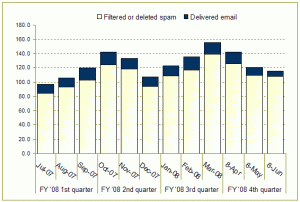Spam is the practice of sending unwanted, unsolicited emails to a large number of people. Unfortunately, it is becoming a common practice of small businesses and internet marketers trying to sell their products or services. It is estimated that the average computer’s email box is filled with at least 30% spam. As a result, there is a rather large demand calling for anti-spam software and filters to become more available to help alleviate the problem.

The bad news about spam is that it is relatively easy to do. All a spammer needs to do is collect a great number of email addresses and/or website addresses and advertisements can then be sent to email boxes or posted as comments on blogs or forums. Because spammers usually deal with large numbers of emails, they have now resorted to automated spam software programs to harvest new email addresses and websites for them and send the actual spam ads for them. Spam takes many many forms, and it has become a continual annoyance for many people.
 In recent years, many people have sought the use of spam blockers which send the unwanted emails back to the spammer. If the blocker is a filter, it will send the suspicious email to a temporary folder. It is up to the recipient to delete it or accept the email as legitimate. Spam can also fill up websites, blogs, forums, social networks, and even instant messaging programs. With the inception of the iPhone, smart phones, and SMS text messaging, the problem is now extended to the mobile phone industry.
In recent years, many people have sought the use of spam blockers which send the unwanted emails back to the spammer. If the blocker is a filter, it will send the suspicious email to a temporary folder. It is up to the recipient to delete it or accept the email as legitimate. Spam can also fill up websites, blogs, forums, social networks, and even instant messaging programs. With the inception of the iPhone, smart phones, and SMS text messaging, the problem is now extended to the mobile phone industry.
What is even more troublesome for us but beneficial to spammers is that there are no overhead costs to what they do, and the opportunity to become a spammer is very simple. Some spammers even have software that is customized to get around some of the most stringent security measures. Sometimes, all they need to do is reword a headline or misspell a word and the emails or comments look legitimate to most spam filters. The only disadvantage that spammers is have is their need to maintain a large email list; other than that, spamming is extremely easy and can be done with the click of a mouse.
Spamming is against the law in many areas, and it is also frowned upon by many companies and advertising websites. Spammers get around this by using “ghost” computers, or “zombies,” which are pre-programmed to deliver their ads for them. All that they need to do is get around all the security measures in place. Once this is done, they use the ghost computer to send their spam emails.
 Sometimes, spammers will hijack someone else’s email address and send their emails from there. The problem with this is that someone may be accused of spamming and not even know it, as their email is being controlled by another individual. In this scenario, the hijacked email address may be banned as a result, or their ISP may disallow them service. This can be a huge nuisance, as there are hefty fines – even jail sentences – involved with spamming.
Sometimes, spammers will hijack someone else’s email address and send their emails from there. The problem with this is that someone may be accused of spamming and not even know it, as their email is being controlled by another individual. In this scenario, the hijacked email address may be banned as a result, or their ISP may disallow them service. This can be a huge nuisance, as there are hefty fines – even jail sentences – involved with spamming.
Spammers are always figuring out new ways to bother us. Sometimes their email subject lines will simply say, “Howdy!” Unfortunately, spam filters will not catch such simple subject lines, and they make it through to the inbox.
In closing, spam is undeniably easy for rogue computer users to get into. However, more computer users are safeguarding themselves with powerful filters and white/blacklists to allow only those they want to email them. Spammers cannot conquer these blacklists often, and this added protection for computer users offer peace of mind and save them a lot of time from cleaning out their inbox.
Leave a Reply
You must be logged in to post a comment.